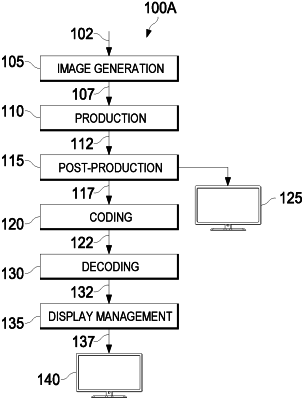| CPC H04N 25/6153 (2023.01) [G06T 5/009 (2013.01); G06T 5/40 (2013.01); G06T 7/90 (2017.01); H04N 19/186 (2014.11); H04N 19/98 (2014.11)] | 27 Claims |

|
1. A device for determining a backward reshaping function, comprising:
an electronic processor configured to:
determine a set of sample pixels from received video data;
define, from the set of sample pixels, a first set of sample pixels according to a first electro-optical transfer function in a first color representation of a first color space;
convert the first set of sample points according to the first electro-optical transfer function to a second electro-optical transfer function in the first color representation of the first color space via a mapping function, producing, from the first set of sample pixels, a second set of sample pixels according to the second electro- optical transfer function;
convert the first set of sample pixels and the second set of sample pixels from the first color representation to a second color representation of the first color space;
determine a backward reshaping function based on the converted first set of sample pixels and the converted second set of sample pixels;
wherein the electronic processor is configured to determine the backward reshaping function by repeatedly applying and adjusting a sample backward reshaping function so as to minimize a difference between predicted pixel values obtained by applying the sample backward reshaping function to the pixels in the converted first set of sample pixels, and the pixels in the converted second set of sample pixels,
wherein the received video data comprise one or more first image in a first dynamic range and the second set of sample pixels belong to one or more second images in a second dynamic range, the first dynamic range being lower than the second dynamic range, and wherein the electronic processor is further configured to determine
a first cumulative density function based on a first histogram generated from a first distribution of codewords in the one or more first images,
a second cumulative density function based on a second histogram generated from a second distribution of codewords in the one or more second images, and
a histogram transfer function based on the first cumulative density function and the second cumulative density function for determining the backward reshaping function.
|